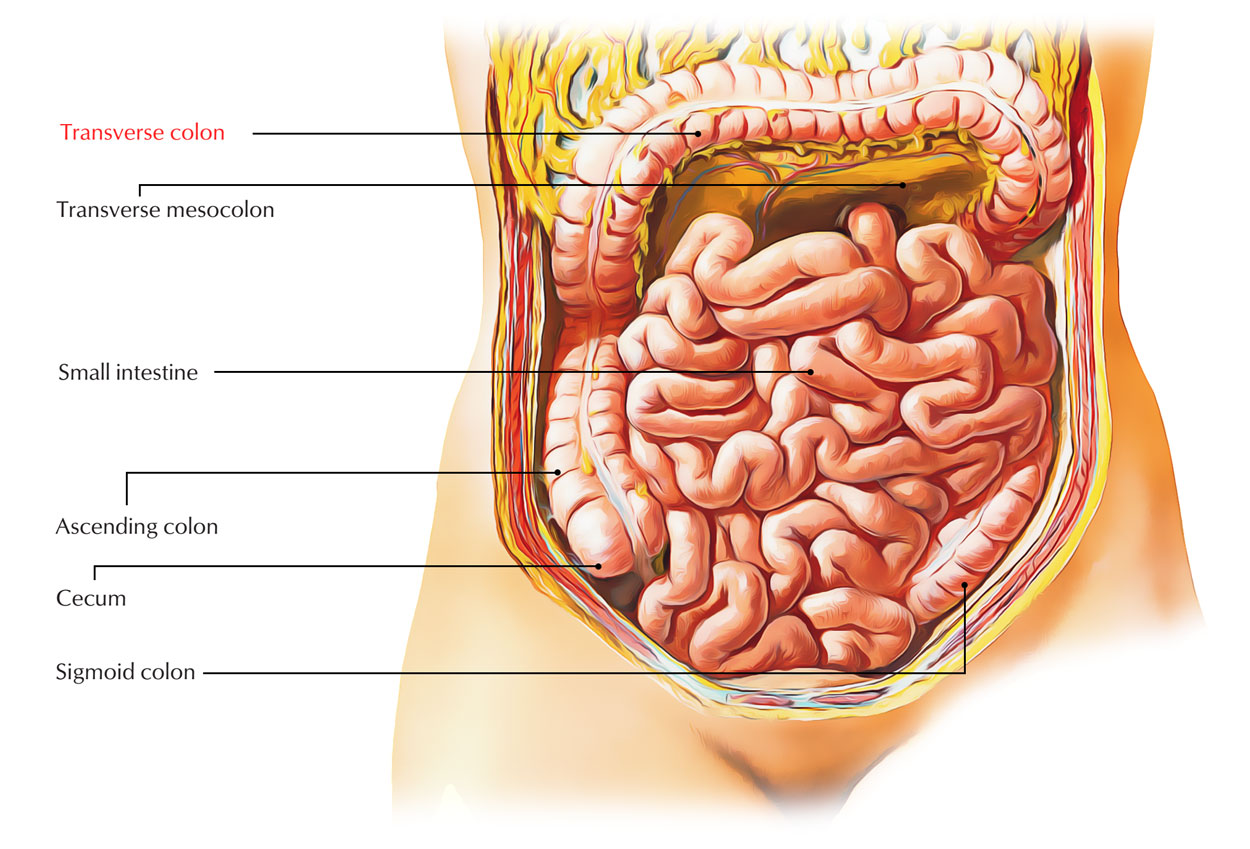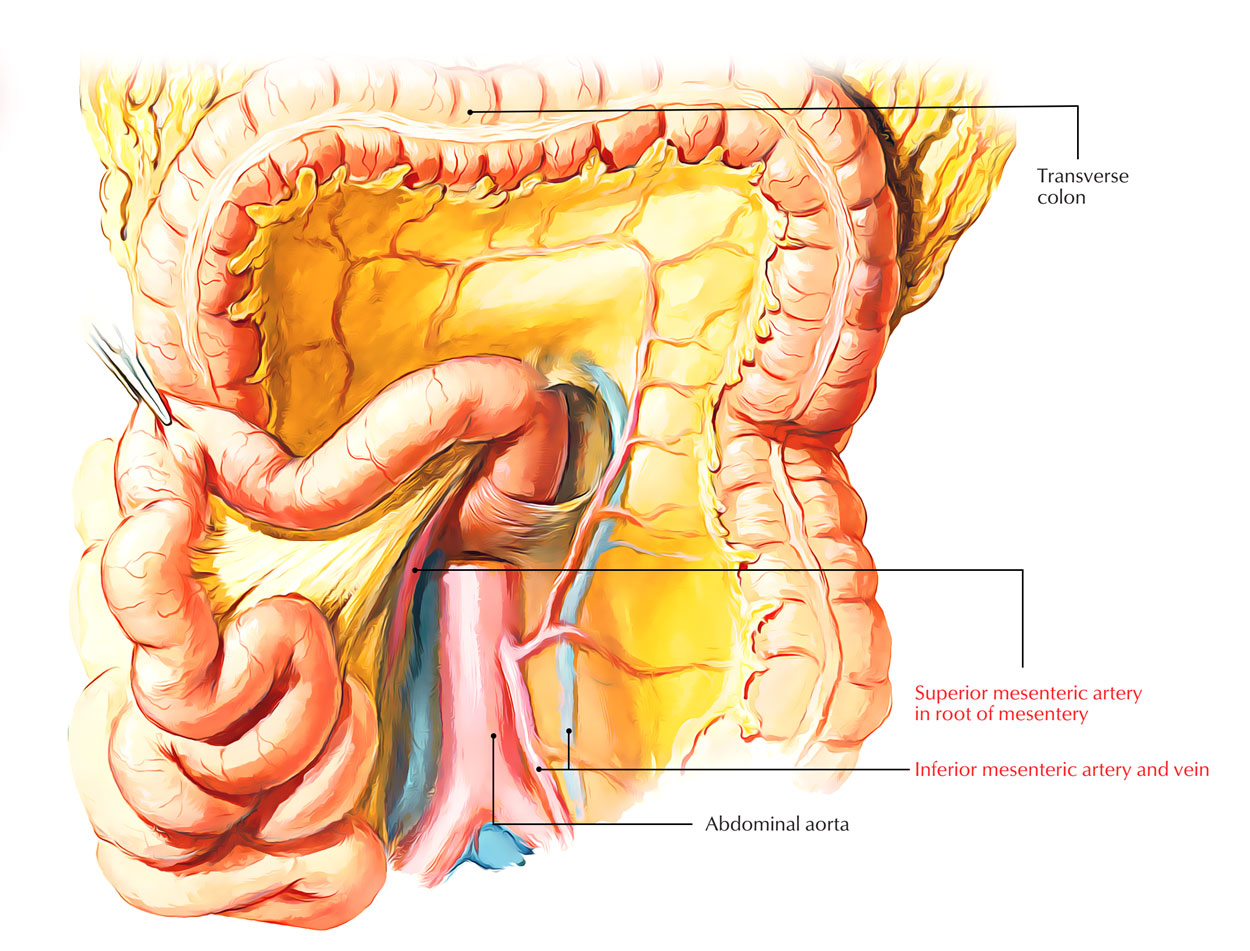Transverse colon is the longest (20 inch/50cm in length) and most active part of the large intestine. It stretches via the right colic flexure (in right lumbar region) to the left colic flexure (in the left hypochondriac region).
Transverse colon is not transverse however creates a reliant loop in front of loops of small intestine in between the right and left colic flexures.The most affordable point of loop generally extends around the level of umbilicus however might often expand into the pelvis. Therefore, the transverse colon is generally ‘U’- shaped.
Relations of Transverse Colon
- Anterior: Greater omentum and anterior abdominal wall.
- Posterior: Second part of the duodenum, head of the pancreas, and coils of the jejunum and ileum.

Transverse Colon
Blood Supply of Transverse Colon
Arterial
- Middle colic artery (division of superior mesenteric artery) supplies proximal 2/3.
- Ascending branch of left colic artery supplies distal 1/3.

Arterial Supply of Transverse Colon
Venous
Via likewise called veins to splenic vein to the portal venous system.
Nerve Supply of Transverse Colon
Sympathetic
- Superior mesenteric plexus.
- Inferior mesenteric plexus.
Parasympathetic
Originated from pelvic splanchnic nerves (S2-S4).
Lymphatic Drainage of Transverse Colon
Lymphatics accompany vessels and drain to paracolic nodules to the superior mesenteric group (proximal two-thirds) and inferior mesenteric group (distal two-thirds).
Clinical Significance of Transverse Colon
Colon Conditions
- Colitis: Swelling of the colon. Inflammatory bowel disease or infections are the most usual causes
- Diverticulosis: Small weak locations in the colon’s muscular wall enable the colon’s lining to extend through, creating small sacks called diverticuli. Diverticuli generally trigger no problems, however can bleed or end up being swollen or infected
- Diverticulitis: When diverticuli end up being swollen or contaminated, diverticulitis outcomes. Abdominal pain, fever, and irregularity prevail symptoms
- Colon bleeding (hemorrhage): Multiple future colon issues can trigger bleeding. Quick bleeding shows up in the stool, however really sluggish bleeding may not be
- Inflammatory bowel disease: A name for either Crohn’s disease or ulcerative colitis. Both conditions can trigger colon inflammation (colitis)
- Crohn’s disease: An inflammatory condition that generally impacts the colon and intestinal tracts. Abdominal pain and diarrhea (which might be bloody) are symptoms
- Ulcerative colitis: An inflammatory condition that generally impacts the colon and rectum. Like Crohn’s disease, bloody diarrhea is a common sign of ulcerative colitis
- Diarrhea: Stools that are regular, loose, or watery are frequently called diarrhea. The majority of diarrhea is because of self-limited, moderate infections of the colon or small intestine
- Salmonellosis: The germs Salmonella can pollute food and contaminate the intestine. Salmonella triggers diarrhea and stomach cramps, which generally solve without treatment
- Shigellosis: The germs Shigella can pollute food and attack the colon. Symptoms consist of fever, stomach cramps, and diarrhea, which might be bloody
- Traveller’s diarrhea: Many various germs typically pollute water or food in establishing nations. Loose stools, often with queasiness and fever, are symptoms
- Colon polyps: Polyps are small developments. A few of these turn into cancer, however it takes a long period of time. Eliminating them can avoid lots of colon cancers
- Colon cancer: Cancer of the colon impacts more than 100,000 Americans each year. The majority of colon cancer is avoidable through routine screening

 (48 votes, average: 4.70 out of 5)
(48 votes, average: 4.70 out of 5)